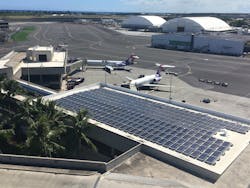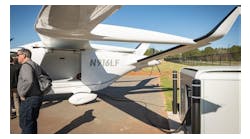The first mission of every airport is to provide for the safety, comfort and experience of its passengers, tenants, employees and visitors. Airports also contribute to the local economy and global productivity, making it increasingly more critical that they operate efficiently, reliably and safely.
Integrating business and information technology, airport and building systems can help create smart, safe, productive and efficient airports. An optimized and integrated infrastructure streamlines communications and work flow even as it provides travelers with helpful tools like wayfinding and Wi-Fi connectivity and assists with check-in and gate processing. But just as impactful to passenger comfort, airport operations and the bottom line are solutions that introduce energy efficiency—those that look at lighting and water use, for example, and offer improvements that reduce energy consumption and increase operational efficiencies. Nowhere is this better demonstrated than in airports operated by the state of Hawaii.
The eight main islands of Hawaii are the most remote islands in the world, limiting accessibility to the islands to travel via airplanes and ships. Located approximately 2,500 miles from the nearest populated landmass, the islands that once supported an agriculture-based economy now attract tourists in large numbers, seduced by the state’s lush natural resources. As a result, tourism has replaced agriculture as the leading industry in the state. The Hawaii Tourism Authority reports some 8.9 million people visited the islands in 2016, a 3 percent increase from 2015. In addition to tourism, intra-island travel is also growing due to increased business and resident travel, resulting in a 10 percent total increase in airline passengers.
Tourism increases demand for energy
With numbers like these comes an increased demand for energy in a state that relies on fossil fuel for 90 percent of the energy it consumes at almost three times the cost the mainland incurs. In fact, the state imports more than $5 billion of oil every year, with the majority of the fuel tied to transportation, moving goods, people and services around and between islands. And because a series of islands comprise the state, there is no inter-island grid that can backup whatever utility is on any particular island. Each island must be self-sufficient where energy production is concerned.
To address the unique challenges the islands face, the state’s leaders worked with Governor David Ige to create his Hawaii Sustainability Plan. The plan’s ambitious goals include a call for the state to rely 100 percent on renewable energy for its electricity by 2045. Because Hawaii welcomes millions of visitors each year to its airports, it came as no surprise that the plan focused attention on the state’s aging airports, along with its harbors and highways. With the help of Johnson Controls Inc., transportation leaders took unprecedented steps to reduce energy consumption on every island.
The Hawaii Department of Transportation (HDOT) has jurisdiction over the state’s airports, harbors and highways. Because these entities consume the majority of the fuel the state imports, transportation leaders seized the opportunity to lead by example as they worked to reduce their energy consumption.
Airports suffer from deferred maintenance
Built in the 1970s, Hawaii’s aging airports had suffered the consequences of deferred maintenance. Many of their chillers that produce air conditioning were at the end of their useful life. Piping systems for chillers leaked, losing water to the ground. Pumps were declining, aging air handlers and failed pneumatic control systems resulted in hot and cold spots throughout the facilities, and the overall appearances of the airports were not much better than the equipment they housed.
To address these and other issues, HDOT established several key goals. At the top of their list, the department sought to reduce energy usage and demand by increasing energy efficiency and building performance. At that time, the state’s energy costs were two to three times the national average.
In addition, HDOT wanted to improve the management and efficiency of utility usage through monitoring and submetering. Reducing facility lifecycle costs, including maintenance, equipment replacement, energy and water utilities, waste disposal, emergency power outages, etc., was also on their list of goals, along with improving the quality of the indoor environment for building occupants. Finally, HDOT planned to implement deferred repair and maintenance projects.
To accomplish all of this, HDOT partnered with Johnson Controls and initiated a ground-breaking set of projects designed to reduce energy consumption and create a more sustainable transportation infrastructure. The project scope included an investment of more than $300 million in energy improvements to airports, harbors and highways, with anticipated energy savings of $776 million.
Hawaii signs largest single-state energy performance contract
To finance the project, the state entered into an energy performance contract with Johnson Controls in 2012. This alternative to traditional funding has been a successful model for procuring energy efficiency retrofits in the public sector for more than 20 years. The contract uses energy and operational savings over a specified time period to fund infrastructure improvements. The projects are designed so that the annual energy and operational savings are greater than or equal to the required payments over the term of the contract, leaving a net neutral impact on a customer’s budget, in this case, the budget of HDOT. Any annual shortfall in savings is paid by Johnson Controls. Guaranteeing the state of Hawaii estimated savings of $776 million made this the largest single-state energy savings performance contract in the United States.
The first phase of the contract focused on 12 of Hawaii’s 15 airports, which are operated by the Airports Division of HDOT. Johnson Controls helped the department identify and prioritize projects, including more than 900 individual conservation measures, and then set to work, replacing nearly 75,000 lighting fixtures with high-efficiency light-emitting diode (LED) technologies and other energy-efficient lighting. Projects that stretched over two years also included upgrading the heating, ventilation and air-conditioning (HVAC) systems to more efficiently keep spaces cool and comfortable; installing 9,100 solar photovoltaic (PV) panels to generate renewable energy; addressing deferred maintenance, including roof repairs and equipment replacement; and looking for cost savings, such as fuel switching, demand reduction, on-site generation, electrical submetering, automated utility bill auditing, utility rate changes and distribution upgrades. This $158 million investment in airport energy improvements is guaranteed to generate savings of more than $500 million over 20 years.
Phase 2 fueled by success of Phase 1
The success of these projects led to a second phase of energy improvements at these same airports. Unlike Phase 1, which focused on those areas of the airports visible to the public, Phase 2 looks at improvements to behind-the-scenes offices and workspaces. Construction has just started on Phase 2 and will be completed in March 2019. The energy performance contract guarantees an additional $65 million in energy savings through the replacement and retrofit of 47,747 existing fluorescent lamps, bringing the total number of new light fixtures in the airports to 98,000, when combined with those replaced during Phase 1.
Workers will apply high-end trim to 8,256 LED fixtures and install 15,683 PV panels, including parking lot canopy and ballasted roof systems at Honolulu International Airport capable of producing 5.3 megawatts of power. When combined with the PV panels installed during Phase 1, the newly outfitted airports will be able to generate 8 megawatts of power.
Airports reduce energy use by 63 million kilowatt hours per year
Improvements like these are making a significant contribution to energy efficiency in Hawaii and are increasing the state’s economic value by reducing energy usage at airports as much as 63 million kilowatt hours per year over the 15-year performance period. This is equivalent to powering 9,264 homes a year. Over the life of the project, the energy saved could power more than 175,000 homes. In the meantime, the utility costs to operate Hawaii’s airports have been cut in half.
The economic impact to Hawaii also includes:
- $27.3 million in tax revenue
- $186.6 million in income to households
- 867 jobs generated or supported each year during the first two years of construction in Phase 1
- 1,257 jobs each year during the two-years of Phase 2 construction
Like Phase 1, Phase 2 is financed by realized savings, not taxpayer money, so the state is benefitting without cost and protecting its valuable natural resources at the same time. These are the benefits of an energy performance contract.
The investment the state of Hawaii has made in its airports and the return on those investments in terms of energy savings and operational efficiencies demonstrates the impact a large-scale efficiency project can have on the state’s sustainability goals. Aggressive energy policies and renewable resources are reducing the need to generate electricity from fossil fuel. Additionally, it sets an example for other agencies and private companies throughout Hawaii.
Harbors and highways also part of energy performance contracts
The good news doesn’t end there. Johnson Controls is also working on energy performance contracts to improve efficiency for the harbors and highways divisions within HDOT. A combination of lighting retrofits, new PV panels and upgraded HVAC systems and controls will result in $36 million in energy savings for Hawaii’s harbors and reduce energy costs along the state’s highways by 43 percent.
By providing zero cutoff fixtures that meet the state law for night sky protection and changing the color of light near sensitive turtle nesting areas, HDOT is showing its commitment to the protection of the environment. It’s just one example of Johnson Controls’ ‘ohana (family spirit) and commitment to the culture of Hawaii.
In another example, Johnson Controls is testing new LED technology that would meet the technical requirements of the Federal Aviation Administration for ramp lighting at airports while also limiting the amount of “blue” light that benefits the astronomical observatories on the islands.
In addition to maintaining the savings guaranteed under the contracts, Johnson Controls developed a customized maintenance program to ensure equipment continues to function optimally over time. Planned service agreements address issues, such as unforeseen equipment failures, budget constraints and the desire by HDOT to perform some maintenance tasks in house. They will also help HDOT protect its investment well into the future.
Initiatives in Hawaii continue to generate industry accolades. For five years in a row, the Energy Service Coalition named Hawaii “first in the nation” for per-capita investment in energy performance contracting. Meanwhile, Hawaii’s airports, harbors and highways are transforming the way energy is used, reflecting an unprecedented commitment to reduce demand for fossil fuels and preserve Hawaii’s Pacific paradise for generations to come.
Michael is responsible for business development of energy management and energy conservation services and is the primary Johnson Controls facing representative for the Hawaii Department of Transportation (HDOT). His expertise in energy and business management provides a unique understanding of the technological and economic trends affecting HDOT, helping to ensure a collaborative partnership and successful series of projects.



